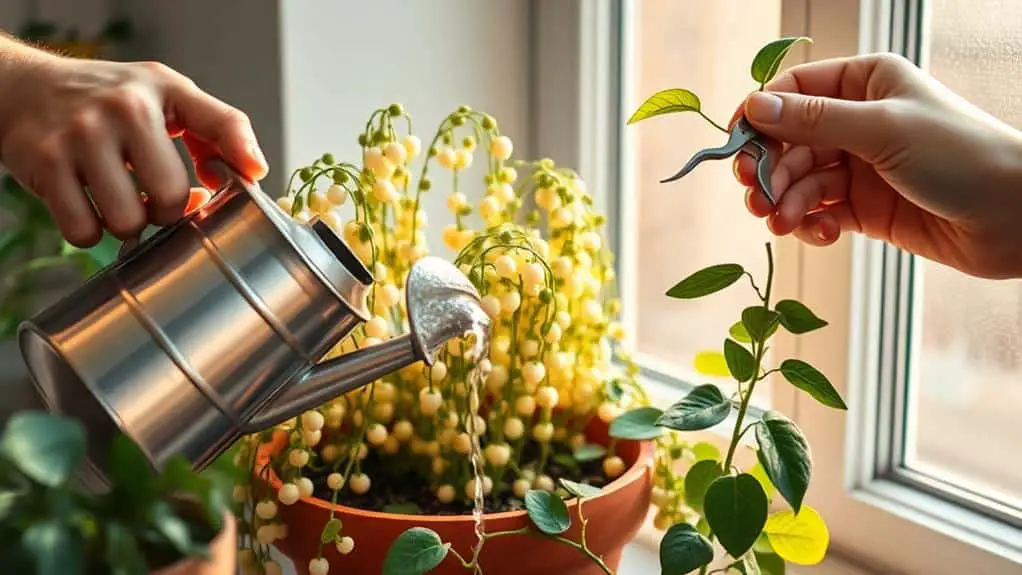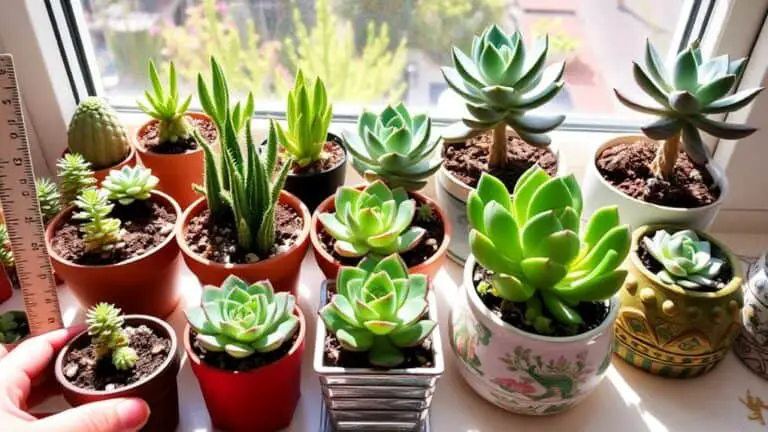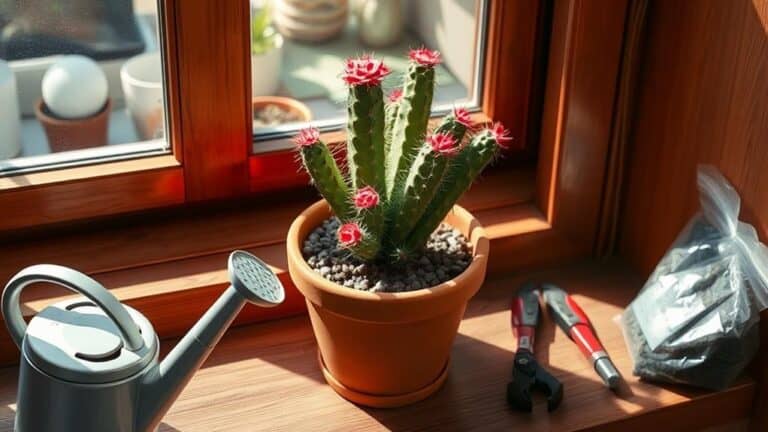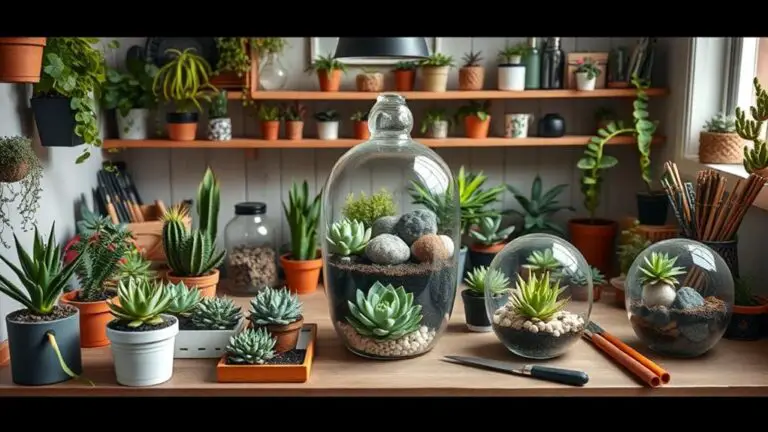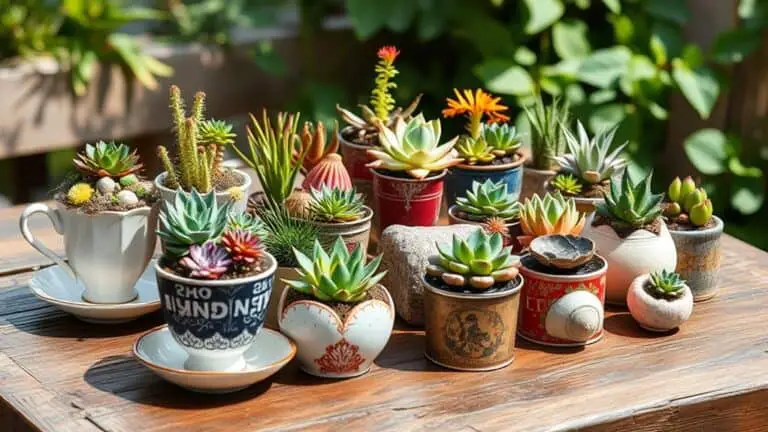10 Essential Steps to Care for Your String of Pearls
Taking care of your String of Pearls plant isn't as intimidating as it might seem. You need to follow ten essential steps to guarantee it thrives, starting with selecting the right pot and soil. Providing the proper light and carefully managing your watering routine are vital. Don't forget to monitor humidity levels and prune regularly to keep your plant in top shape. Repotting annually and knowing how to propagate with stem cuttings can also make a big difference. Let's explore these steps in detail and see how you can create the perfect environment for your String of Pearls.
Select the Right Pot

Choosing the right pot for your String of Pearls is essential for its health and growth. When selecting a pot, go for one that's slightly larger than the original plastic pot. This gives your plant's shallow roots enough space without overwhelming them.
Terra-cotta or unglazed ceramic pots are excellent choices. These materials help wick away excess moisture, which is critical for preventing waterlogging and root rot.
Make sure the pot has drainage holes. These holes are important because they allow excess water to escape, ensuring the roots don't sit in water. String of Pearls plants don't like soggy conditions; they thrive when their roots can breathe.
A shallow container is key. This succulent prefers limited root depth. Deep pots can hold too much moisture, which isn't ideal for your plant.
Pair your chosen pot with a well-draining succulent soil mix. Look for a mix that includes components like sand or perlite. These elements enhance aeration and drainage, helping your plant stay healthy.
Use Well-Draining Soil
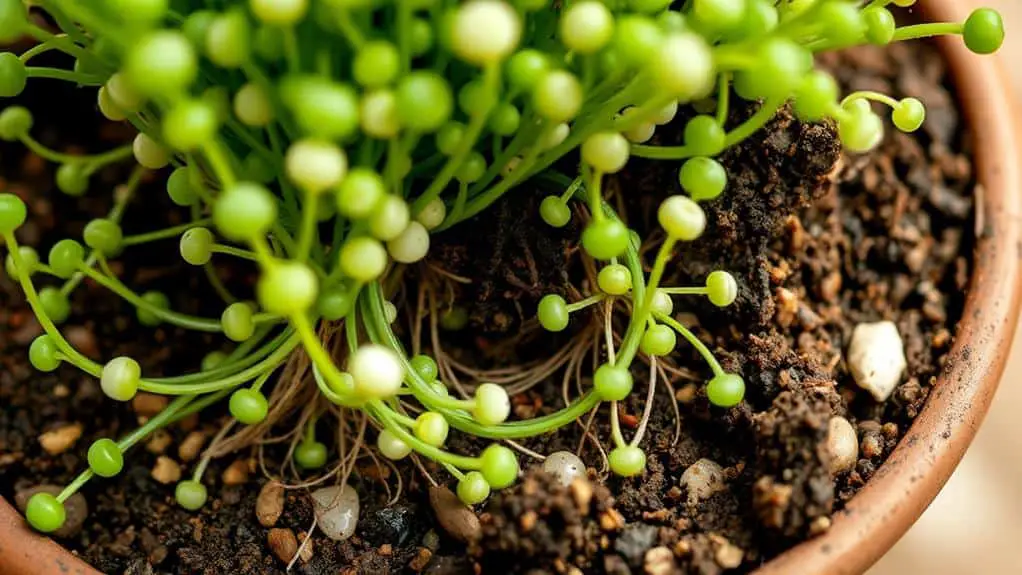
For your String of Pearls to thrive, well-draining soil is non-negotiable. You need a mix that allows water to flow through easily, preventing the dreaded root rot. A good option is a cactus potting soil combined with perlite or sand. This blend enhances aeration and keeps water from lingering around the roots.
Creating a sandy soil mix is simple. Combine three parts potting soil with one part sharp sand. This ratio guarantees quick drainage and keeps your plant's roots healthy.
Also, consider using a terracotta or unglazed ceramic pot. These materials help wick away excess moisture, letting the soil dry out between waterings.
When potting, choose a container just slightly larger than the original. This gives shallow roots space to grow without leaving too much wet soil around them that could lead to root rot.
Remember to regularly check your soil quality and moisture levels. Avoid heavy garden soil at all costs, as it holds water and greatly increases the risk of root rot.
With these tips, you'll create the perfect environment for your String of Pearls, guaranteeing it stays healthy and vibrant. Happy planting!
Provide Bright, Indirect Light
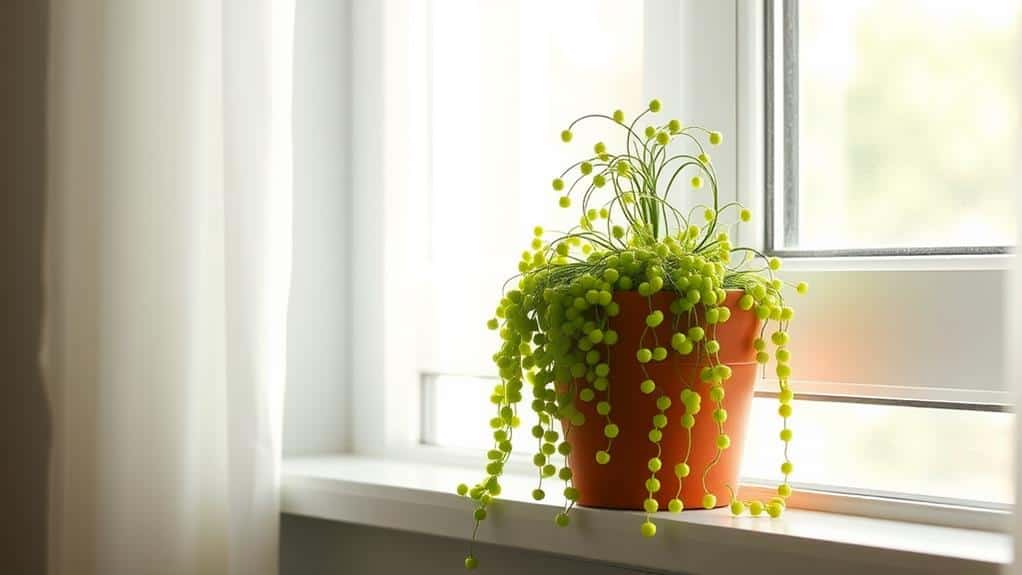
To keep your String of Pearls healthy, ensuring it gets bright, indirect light is essential. This plant thrives best when it receives 4-6 hours of bright, indirect sunlight each day. Ideal spots include east or west-facing windows, where the light is just right for peak growth.
Direct sunlight, however, can be too intense and might scorch the delicate pearls. So, if you're placing your plant outside, make sure to provide some shade during the hottest parts of the day.
If your home doesn't have enough natural light, don't worry! You can supplement light exposure with fluorescent lights. Aim to keep these lights on for 12-16 hours daily to mimic the bright, indirect light your String of Pearls loves.
During the darker winter months, adjusting your lighting setup can help prevent issues like shriveling leaves.
Always observe your plant's response to its light conditions. If you notice the leaves stretching or turning pale, it's a sign that your plant isn't getting enough light.
Water Sparingly
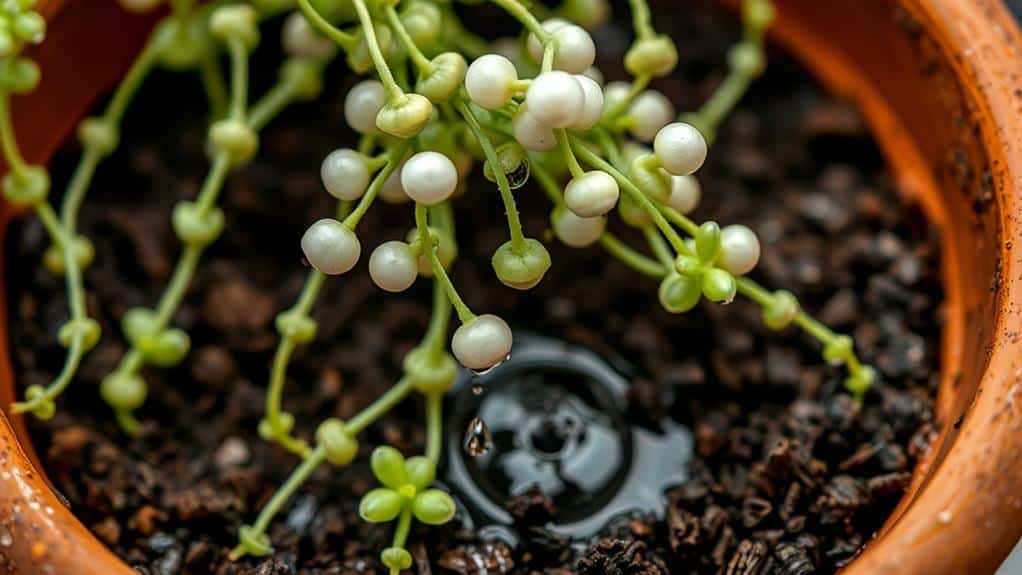
While getting the light conditions right is important, managing your String of Pearls' watering needs is equally essential.
Water your plant every 2-3 weeks during the growing season (spring and summer). Make sure the top half-inch of soil has dried out before adding more water. This helps maintain slightly moist soil without drowning the roots.
In winter, when your plant enters dormancy, reduce watering to about once a month. Let the soil dry out completely between waterings to prevent root rot. If you notice shriveling or wrinkling leaves, it's a sign your plant might be thirsty, but remember, underwatering is better than overwatering.
Always use lukewarm to cool water. Extreme temperatures can harm your String of Pearls.
Bottom watering is the best method. It allows the plant to absorb moisture from the soil without wetting the leaves, which helps prevent fungal issues.
Monitor Humidity Levels

Maintaining the right humidity levels is crucial for your String of Pearls. These plants thrive in low humidity environments, ideally around 40%, because they're native to the dry regions of East Africa.
To keep your plant healthy, follow these simple steps:
- Check Humidity Levels: Standard household humidity is generally sufficient. However, avoid placing your plant in high-humidity locations like bathrooms or near humidifiers.
- Guarantee Proper Ventilation: Excess humidity can lead to fungal issues and root rot. Keep your String of Pearls in a well-ventilated area to prevent moisture-related problems.
- Monitor During Winter: Indoor heating can lower humidity levels considerably during winter. Keep an eye on your plant's condition and move it if necessary to maintain ideal growth conditions.
Being proactive about the humidity in your home can save your plant from many potential issues.
Remember, your String of Pearls doesn't need special humidity adjustments. Just guarantee it's not in overly damp areas.
If you notice any signs of distress, like yellowing leaves or a mushy stem, consider adjusting its location to a drier, well-ventilated spot. This will help your plant thrive and stay beautiful all year round.
Fertilize Annually
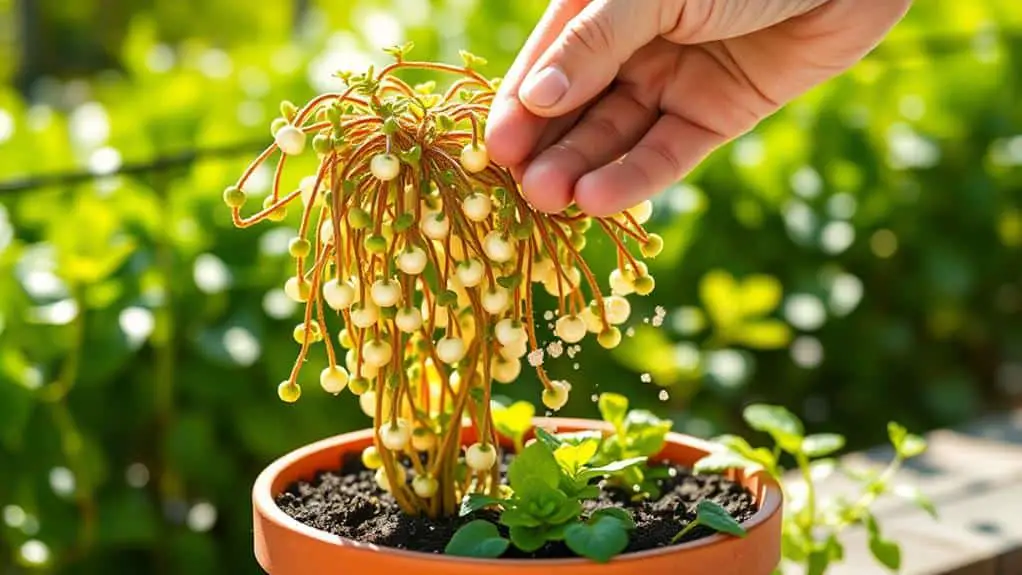
To keep your String of Pearls healthy and thriving, fertilize it once a year during the growing season, which is spring and summer.
Use a balanced NPK liquid fertilizer at half the recommended rate, and make sure to apply it when the soil is slightly moist.
Avoid fertilizing in fall and winter, as the plant won't need as many nutrients during its dormancy.
Optimal Fertilizer Choice
Fertilizing your String of Pearls annually during the growing season is crucial for its healthy growth and blooming. To get the best results, you'll want to use a balanced NPK liquid fertilizer. Dilute it to half the manufacturer's recommended strength. This way, you provide the nutrients your plant needs without overwhelming it.
Here's a simple guide to help you:
- Use a balanced NPK liquid fertilizer: Choose a fertilizer with equal parts nitrogen (N), phosphorus (P), and potassium (K). This balance supports all-around plant health.
- Dilute to half strength: Too much fertilizer can harm your plant. Diluting to half strength guarantees gentle feeding.
- Apply every 4-6 weeks: During the active growing season (spring and summer), fertilize your String of Pearls every 4-6 weeks.
Confirm the soil is slightly moist before you apply the fertilizer to prevent root burn and help the plant absorb nutrients better.
Keep an eye on your plant's response. If it shows signs of stress, adjust the frequency or concentration. By following these steps, you'll support your String of Pearls in achieving healthy growth and beautiful blooming.
Seasonal Fertilization Schedule
After selecting the right fertilizer, it's important to establish a consistent seasonal fertilization schedule for your String of Pearls. To promote healthy growth and blooming, you should fertilize your plant annually during the growing season, which typically spans from spring to summer.
Using a balanced NPK liquid fertilizer diluted to half the manufacturer's recommended rate is essential. This helps avoid nutrient burn. Be certain to apply the fertilizer once a month during the active growing period. This schedule guarantees your String of Pearls gets the essential nutrients it needs without over-fertilizing.
Before you fertilize, check that the soil is slightly moist. Moist soil promotes better nutrient absorption and prevents root damage. You can easily do this by lightly watering the plant before applying the liquid fertilizer.
It's also important to monitor your plant's growth response after fertilization. Keep an eye on its health and vigor. If you notice any changes, you might need to adjust the frequency or concentration of the fertilizer. This guarantees your String of Pearls receives the right amount of nutrients for peak growth.
Proper Dosage Tips
When it comes to fertilizing your String of Pearls, getting the dosage right is essential to maintaining its health. Annual fertilization is key, and here's how to do it properly:
- Use a balanced NPK liquid fertilizer: Opt for a product that contains equal parts nitrogen (N), phosphorus (P), and potassium (K). Dilute it to half the manufacturer's recommended strength to prevent over-fertilizing.
- Apply to slightly moist soil: Before you fertilize, make sure the soil is slightly moist. This helps avoid root burn and allows your plant to absorb nutrients more effectively.
- Stick to the annual schedule: Fertilize once a year during the growing season, typically in spring. Over-fertilizing can cause weak stems and excessive growth, which you don't want.
If your plant seems sluggish, consider a light feeding every 4-6 weeks during the active growing season.
But remember, reduce or stop fertilizing during fall and winter when the plant is dormant. This prevents nutrient buildup in the soil, which could harm your plant.
Prune Regularly

Regular pruning is key to keeping your String of Pearls looking its best.
Use clean, sharp scissors to remove any dead stems and trim back long branches with few beads.
This encourages fuller growth and helps your plant stay healthy and vibrant.
Remove Dead Stems
Keeping your String of Pearls in top shape requires consistent pruning to remove dead or leggy stems.
Regularly inspecting your plant for these stems not only keeps it looking fresh but also encourages healthy growth.
Here's how to do it effectively:
- Inspect your plant: Look for any dead stems or those that seem leggy and weak. These parts need to be trimmed to keep the plant in good condition.
- Use the right tools: Grab a pair of clean, sharp scissors. Cut the dead stems just above a leaf node. This promotes new growth from the healthy parts left behind.
- Timing is key: It's best to prune during the growing season, which is spring and summer. This allows your plant to recover and flourish quickly.
Encourage Fuller Growth
To encourage fuller growth in your String of Pearls, make pruning a regular part of your plant care routine. Regularly pruning dead or leggy stems promotes bushier growth and prevents your plant from looking sparse. Use clean, sharp scissors to trim back any long or unhealthy stems, ideally removing about one-third of the length to stimulate new growth. This should be done during the growing season, which is spring and summer, to maximize the plant's response and encourage a fuller appearance.
When pruning, focus on trimming stems that have few leaves or seem unhealthy. This allows the plant to redirect its energy to healthier parts, boosting overall vigor. Additionally, you can propagate new plants using the healthy cuttings from your pruning. These cuttings will root within a few weeks, giving you more String of Pearls plants to enjoy or share.
Here's a quick guide to help:
| Task | Action |
|---|---|
| Pruning Frequency | Regularly, during spring and summer |
| Amount to Trim | About one-third of the stem length |
| Propagation Timing | Use healthy cuttings right after pruning |
Use Clean Tools
Maintaining clean tools is essential when pruning your String of Pearls to guarantee the plant stays healthy and vibrant.
Regular pruning helps you maintain its appearance by removing leggy or dead stems, which promotes a fuller and more attractive plant. To do this effectively, use clean, sharp scissors to trim the stems. This prevents the introduction of harmful pathogens that could damage your plant.
Follow these steps for successful pruning:
- Inspect: Look for any signs of distress, such as yellowing leaves or excessively long stems. This helps you determine what needs to be cut to encourage healthy growth.
- Prune: Trim during the growing season, ideally in spring and summer. This allows the plant to recover quickly and produce new growth.
- Propagate: After pruning, place healthy cuttings in well-draining soil. This can help you create new plants and enhance the overall density of your collection.
Repot Annually in Spring
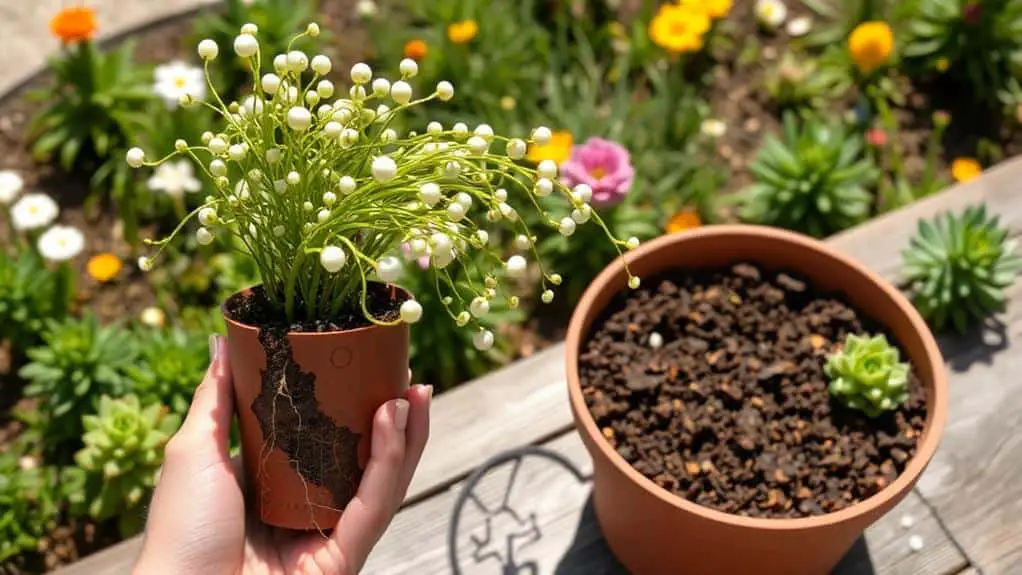
Repotting your String of Pearls annually in early spring is fundamental for its health and growth. To start, you'll need a new pot that's about 10-20% larger in diameter than the previous one. This gives your plant fresh soil and more room to expand.
When you repot your String of Pearls, choose a well-draining succulent or cactus potting mix. Adding materials like sand and perlite will enhance drainage and aeration, which is essential for the plant's shallow roots.
Make certain the new pot has drainage holes. These holes are critical because they prevent water from sitting at the bottom, which can cause root rot.
When handling your String of Pearls, be gentle. The stems and roots are delicate, and any damage can affect the plant's growth. Place the crown of the plant level with the top of the pot to guarantee it's correctly positioned.
After repotting, keep a close eye on your plant. It might need a different watering schedule until it gets used to its new home.
Propagate With Stem Cuttings
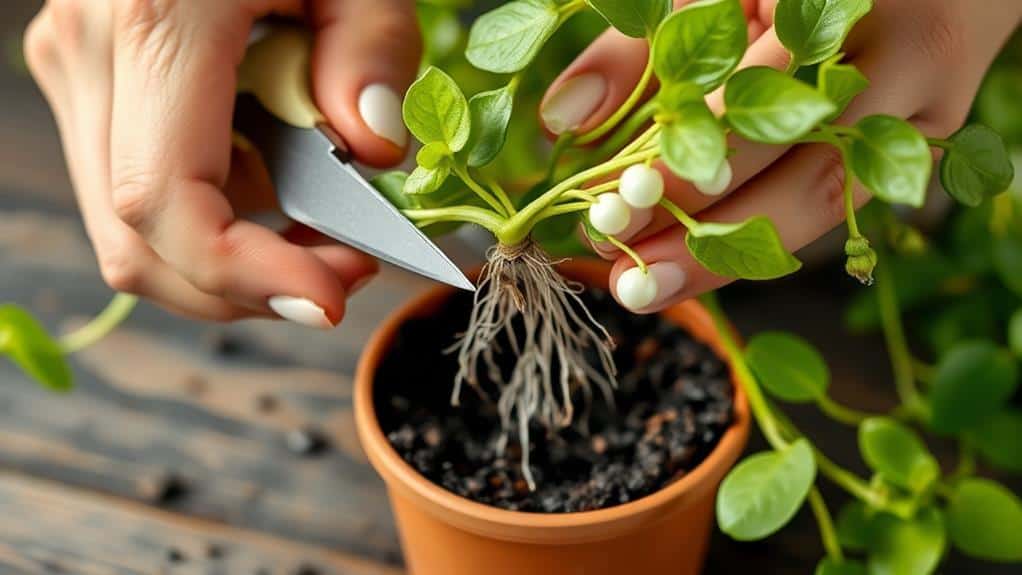
After repotting your String of Pearls in the spring, you might want to propagate new plants to expand your collection or share with friends. To propagate String of Pearls using stem cuttings, follow these easy steps for success.
- Select and Prepare Cuttings: Choose healthy stems that are at least 4-5 inches long. Remove the beads from the bottom part of the stem to expose the nodes, which will help the cuttings root better.
- Callus the Cuttings: Let the cut ends of the stems callus for about 24 hours in a shaded area. This step is significant because it prevents rot and encourages healthy root development.
- Plant and Care: Plant the cuttings in well-draining succulent soil, which is essential for preventing waterlogged roots. Water them lightly—don't overdo it, as too much water can cause rot. Place the cuttings in bright, indirect sunlight to help them grow strong roots.
After 3-4 weeks, you should see roots starting to sprout. At this point, you can care for them as you'd a mature plant, making sure the soil dries out between waterings.
Regularly trimming and propagating your String of Pearls will keep your plants full and vibrant, allowing you to enjoy their beauty even more.
Protect From Pests and Diseases
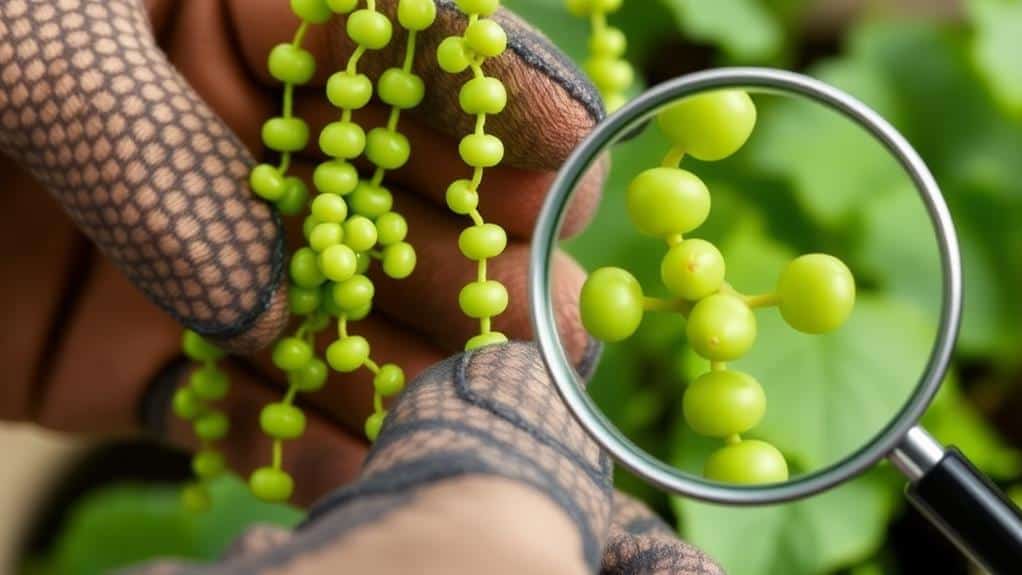
Caring for your String of Pearls involves vigilance, particularly when it comes to pests and diseases. Regularly inspect your plant for common pests like aphids, mealybugs, and spider mites. These pests can cause leaf discoloration and drooping, which hurts your plant's overall health.
If you spot any, don't worry. Use neem oil or insecticidal soap to treat the infestations. Apply the solution directly to the affected areas and repeat every 7-10 days until the pests are gone.
Proper watering practices are essential to prevent root rot. Make sure to allow the soil to dry out completely between waterings. Overwatering can lead to root rot and fungal diseases, which can be fatal to your plant.
Additionally, good air circulation around the plant helps reduce humidity levels, minimizing the risk of fungal growth and rot.
If you notice yellowing or mushy leaves, remove them immediately. This step prevents the spread of disease and helps keep your plant healthy.
Frequently Asked Questions
How to Maintain a String of Pearls?
Place your String of Pearls in bright, indirect sunlight for 6-8 hours daily. Water every 2-3 weeks, let soil dry out completely. Use well-draining soil. Fertilize annually in spring. Check for pests and prune regularly.
How Often Should I Water My String of Pearls?
You should water your String of Pearls every 2-3 weeks in spring and summer, ensuring the soil is slightly moist. In winter, reduce watering to once a month. Always check soil dryness before watering to avoid overwatering.
Do String of Pearls Need to Be Misted?
No, your String of Pearls don't need misting. Misting can actually harm them by causing excess moisture on the leaves, leading to fungal issues. Stick to bright, indirect sunlight and proper watering to keep them healthy.
How Do You Make String of Pearls Happy?
To make your String of Pearls happy, give it bright, indirect sunlight for 6-8 hours daily. Water every 2-3 weeks, let the soil dry out completely, and use well-draining soil. Maintain proper temperatures and fertilize yearly.
Conclusion
By following these ten essential steps, you'll keep your String of Pearls healthy and thriving. Remember to choose the right pot and soil, provide the right light, and water carefully. Don't forget to prune, repot, and keep an eye out for pests. With a little care and attention, your plant will flourish. You've got this—happy gardening!

